万圣节的资料 英语
- 格式:docx
- 大小:13.25 KB
- 文档页数:3
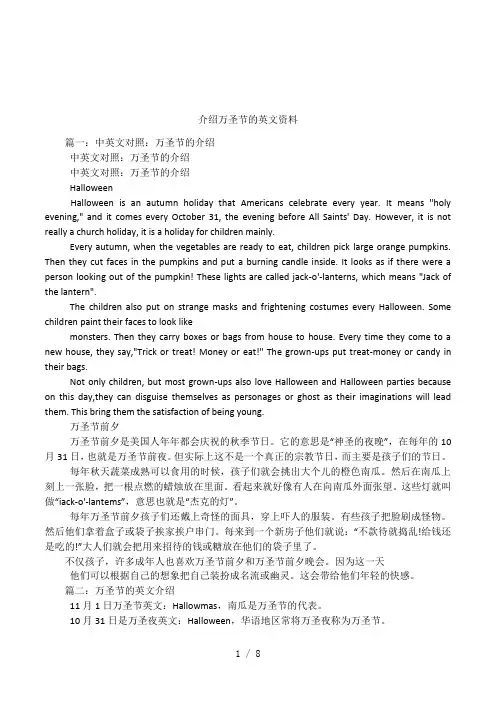
介绍万圣节的英文资料 篇一:中英文对照:万圣节的介绍 中英文对照:万圣节的介绍 中英文对照:万圣节的介绍 Halloween Halloween is an autumn holiday that Americans celebrate every year. It means "holy evening," and it comes every October 31, the evening before All Saints' Day. However, it is not really a church holiday, it is a holiday for children mainly. Every autumn, when the vegetables are ready to eat, children pick large orange pumpkins. Then they cut faces in the pumpkins and put a burning candle inside. It looks as if there were a person looking out of the pumpkin! These lights are called jack-o'-lanterns, which means "Jack of the lantern". The children also put on strange masks and frightening costumes every Halloween. Some children paint their faces to look like monsters. Then they carry boxes or bags from house to house. Every time they come to a new house, they say,"Trick or treat! Money or eat!" The grown-ups put treat-money or candy in their bags. Not only children, but most grown-ups also love Halloween and Halloween parties because on this day,they can disguise themselves as personages or ghost as their imaginations will lead them. This bring them the satisfaction of being young. 万圣节前夕 万圣节前夕是美国人年年都会庆祝的秋季节日。
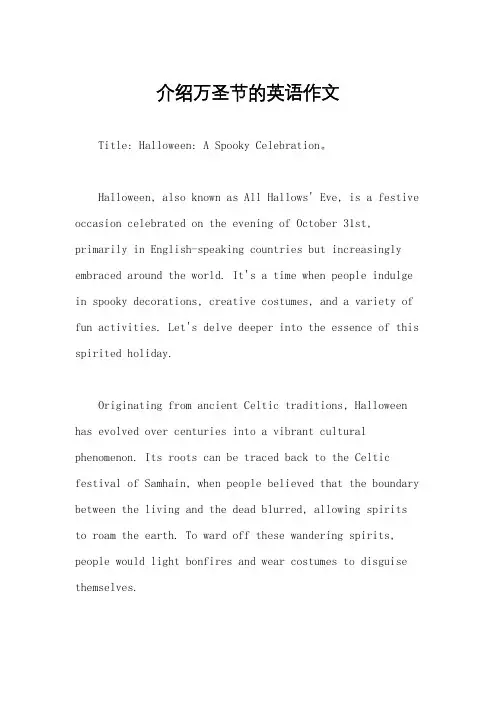
介绍万圣节的英语作文Title: Halloween: A Spooky Celebration。
Halloween, also known as All Hallows' Eve, is a festive occasion celebrated on the evening of October 31st, primarily in English-speaking countries but increasingly embraced around the world. It's a time when people indulge in spooky decorations, creative costumes, and a variety of fun activities. Let's delve deeper into the essence of this spirited holiday.Originating from ancient Celtic traditions, Halloween has evolved over centuries into a vibrant cultural phenomenon. Its roots can be traced back to the Celtic festival of Samhain, when people believed that the boundary between the living and the dead blurred, allowing spirits to roam the earth. To ward off these wandering spirits, people would light bonfires and wear costumes to disguise themselves.One of the most iconic symbols of Halloween is thejack-o'-lantern. Originally carved from turnips or potatoes, these lanterns were meant to scare away evil spirits. The tradition evolved when Irish immigrants brought the customto America, where pumpkins were abundant and easier to carve. Today, carving pumpkins into jack-o'-lanterns is a cherished Halloween tradition for families worldwide.Costume parties are another integral aspect of Halloween festivities. From spooky ghosts to beloved superheroes, people of all ages relish the opportunity to dress up in elaborate costumes. Whether it's DIY creationsor store-bought ensembles, the creativity and imagination displayed in Halloween costumes are boundless. The streets come alive with a kaleidoscope of characters, adding to the festive atmosphere.Trick-or-treating is a beloved tradition, especially among children. Dressed in costumes, they go door to door, shouting "trick or treat!" in exchange for candy and other treats. The origins of this custom can be traced back tothe medieval practice of "souling," where the poor would gofrom house to house, offering prayers for the souls of the dead in exchange for food.Haunted houses, corn mazes, and spooky hayrides are popular attractions during the Halloween season. These immersive experiences offer thrills and chills for those seeking an adrenaline rush. Whether it's navigating through dark corridors or encountering eerie creatures, haunted attractions provide a spine-tingling adventure for thrill-seekers.Halloween wouldn't be complete without indulging in delicious treats. From caramel apples to pumpkin pie, the culinary delights of Halloween are as varied as they are delectable. Whether it's baking homemade treats or sampling seasonal favorites, food plays a central role in Halloween celebrations.In addition to the festivities, Halloween also provides an opportunity for reflection and remembrance. Manycultures believe that during this time, the veil between the living and the dead is thinnest, allowing forcommunication with departed loved ones. It's a time to honor ancestors and celebrate the cycle of life and death.Overall, Halloween is a time-honored tradition that brings communities together in a spirit of fun and camaraderie. Whether it's carving pumpkins, donning costumes, or indulging in sweet treats, the essence of Halloween lies in embracing the spooky and celebrating the supernatural. So, as October 31st approaches, let's join in the festivities and make this Halloween a truly memorable one.。
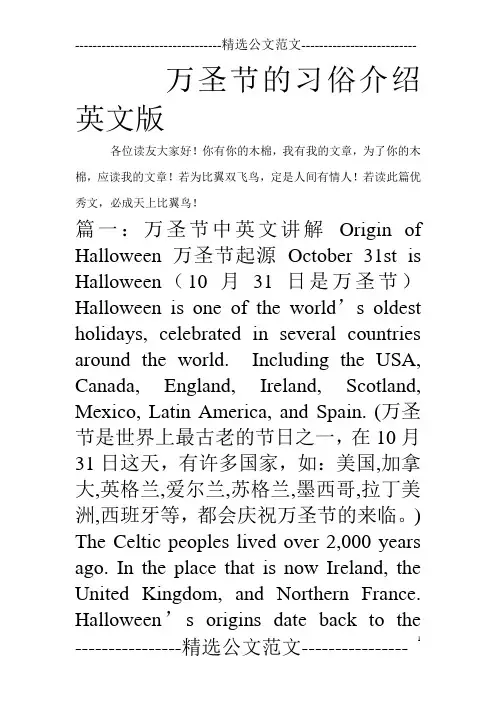
万圣节的习俗介绍英文版各位读友大家好!你有你的木棉,我有我的文章,为了你的木棉,应读我的文章!若为比翼双飞鸟,定是人间有情人!若读此篇优秀文,必成天上比翼鸟!篇一:万圣节中英文讲解Origin of Halloween万圣节起源October 31st is Halloween(10月31日是万圣节)Halloween is one of the world’s oldest holidays, celebrated in several countries around the world. Including the USA, Canada, England, Ireland, Scotland, Mexico, Latin America, and Spain. (万圣节是世界上最古老的节日之一,在10月31日这天,有许多国家,如:美国,加拿大,英格兰,爱尔兰,苏格兰,墨西哥,拉丁美洲,西班牙等,都会庆祝万圣节的来临。
) The Celtic peoples lived over 2,000 years ago. In the place that is now Ireland, the United Kingdom, and Northern France. Halloween’s origins date back to theancient Celtic festival of Sam hain (pronounced sow-in).(在2000多年前的爱尔兰及法国北部,住着一群凯尔特人,而万圣节就是起源于古凯尔特人的一个叫做Sam hain的节庆。
) For the Celtic peoples, the New Year was celebrated on November 1st of every year. This date marked the end of Summer and the beginning of Winter. (凯尔特人选在每年November 1st ,11月1日庆祝新年,正值夏天结束,冬天刚开始的时节,多半让人联想到黑暗的死亡。
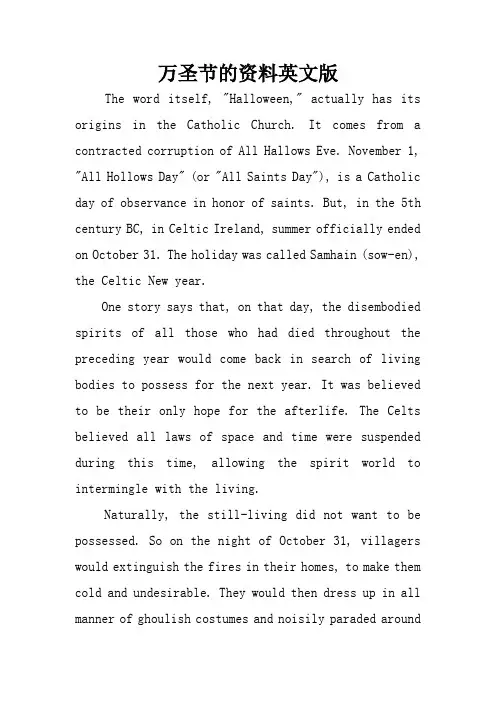
万圣节的资料英文版The word itself, "Halloween," actually has its origins in the Catholic Church. It comes from a contracted corruption of All Hallows Eve. November 1, "All Hollows Day" (or "All Saints Day"), is a Catholic day of observance in honor of saints. But, in the 5th century BC, in Celtic Ireland, summer officially ended on October 31. The holiday was called Samhain (sow-en), the Celtic New year.One story says that, on that day, the disembodied spirits of all those who had died throughout the preceding year would come back in search of living bodies to possess for the next year. It was believed to be their only hope for the afterlife. The Celts believed all laws of space and time were suspended during this time, allowing the spirit world to intermingle with the living.Naturally, the still-living did not want to be possessed. So on the night of October 31, villagers would extinguish the fires in their homes, to make them cold and undesirable. They would then dress up in all manner of ghoulish costumes and noisily paraded aroundThe Jack-o-lantern custom probably comes from Irish folklore. As the tale is told, a man named Jack, who was notorious as a drunkard and trickster, tricked Satan into climbing a tree. Jack then carved an image of a cross in the tree's trunk, trapping the devil up the tree. Jack made a deal with the devil that, if he would never tempt him again, he would promise to let him down the tree.According to the folk tale, after Jack died, he was denied entrance to Heaven because of his evil ways, but he was also denied access to Hell because he had tricked the devil. Instead, the devil gave him a single ember to light his way through the frigid darkness. The ember was placed inside a hollowed-out turnip to keep it glowing longer.The Irish used turnips as their "Jack's lanterns" originally. But when the immigrants came to America, they found that pumpkins were far more plentiful than turnips. So the Jack-O-Lantern in America was a hollowed-out pumpkin, lit with an ember.So, although some cults may have adopted Halloween as their favorite "holiday," the day itself did not growout of evil practices. It grew out of the rituals of Celts celebrating a new year, and out of Medieval prayer rituals of Europeans. And today, even many churches have Halloween parties or pumpkin carving events for the kids. After all, the day itself is only as evil as one cares to make it.Historian Nicholas Rogers, exploring the origins of Halloween, notes that while "some folklorists have detected its origins in the Roman feast of Pomona, the goddess of fruits and seeds, or in the festival of the dead called Parentalia, it is more typically linked to the Celtic festival of Samhain, whose original spelling was Samuin (pronounced sow-an or sow-in)".The name is derived from Old Irish and means roughly "summer's end".Snap-Apple Night (1832) by Daniel apple bobbing and divination games at a Halloween party in Blarney, name 'Halloween' and many of its present-day traditions derive from the Old English era.The word Halloween is first attested in the 16th century and represents a Scottish variant of the fuller All-Hallows-Even ("evening"), that is, the night before All Hallows Day. Although the phrase All Hallowsis found in Old English (ealra hālgena m ssed g, mass-day of all saints), All-Hallows-Even is itself not attested until 1556.。
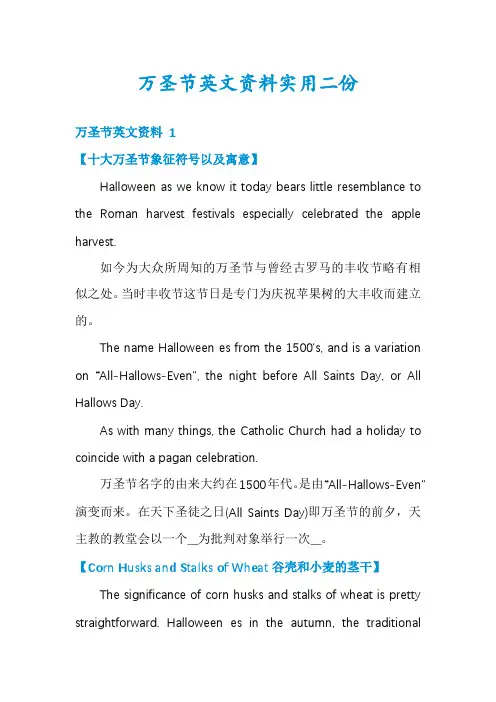
万圣节英文资料实用二份万圣节英文资料 1【十大万圣节象征符号以及寓意】Halloween as we know it today bears little resemblance to the Roman harvest festivals especially celebrated the apple harvest.如今为大众所周知的万圣节与曾经古罗马的丰收节略有相似之处。
当时丰收节这节日是专门为庆祝苹果树的大丰收而建立的。
The name Halloween es from the 1500’s, and is a variation on “All-Hallows-Even”, the night before All Saints Day, or All Hallows Day.As with many things, the Catholic Church had a holiday to coincide with a pagan celebration.万圣节名字的由来大约在1500年代。
是由“All-Hallows-Even”演变而来。
在天下圣徒之日(All Saints Day)即万圣节的前夕,天主教的教堂会以一个__为批判对象举行一次__。
【Corn Husks and Stalks of Wheat谷壳和小麦的茎干】The significance of corn husks and stalks of wheat is pretty straightforward. Halloween es in the autumn, the traditionalfestival celebrated the end of summer and the end of the harvest, so these images are meant to represent the end of harvest and the beginning of winter.Corn and wheat are symbols of agricultural change, and the change of the seasons.稻谷的外壳还有小麦的茎干所传达的意思是非常鲜明的。
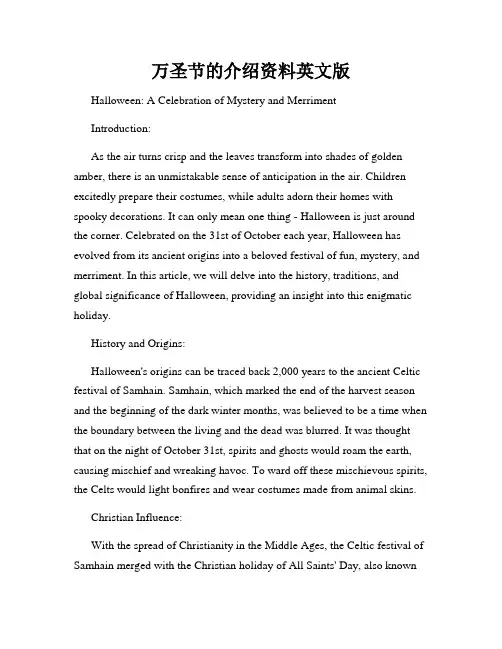
万圣节的介绍资料英文版Halloween: A Celebration of Mystery and MerrimentIntroduction:As the air turns crisp and the leaves transform into shades of golden amber, there is an unmistakable sense of anticipation in the air. Children excitedly prepare their costumes, while adults adorn their homes with spooky decorations. It can only mean one thing - Halloween is just around the corner. Celebrated on the 31st of October each year, Halloween has evolved from its ancient origins into a beloved festival of fun, mystery, and merriment. In this article, we will delve into the history, traditions, and global significance of Halloween, providing an insight into this enigmatic holiday.History and Origins:Halloween's origins can be traced back 2,000 years to the ancient Celtic festival of Samhain. Samhain, which marked the end of the harvest season and the beginning of the dark winter months, was believed to be a time when the boundary between the living and the dead was blurred. It was thought that on the night of October 31st, spirits and ghosts would roam the earth, causing mischief and wreaking havoc. To ward off these mischievous spirits, the Celts would light bonfires and wear costumes made from animal skins.Christian Influence:With the spread of Christianity in the Middle Ages, the Celtic festival of Samhain merged with the Christian holiday of All Saints' Day, also knownas All Hallows' Day. The night before All Hallows' Day became known as All Hallows' Eve, eventually shortened to Halloween. As the centuries passed, Halloween evolved into a secular celebration, with various customs and traditions from different cultures blending together.Traditions and Customs:One of the most iconic symbols of Halloween is the jack-o'-lantern. Originally, turnips or potatoes were carved into intricate designs and placed by doorways to ward off evil spirits. However, when Irish immigrants brought the tradition to America, they discovered that pumpkins were more readily available and easier to carve. Thus, the jack-o'-lantern as we know it today was born.Trick-or-Treating, another popular Halloween tradition, has its roots in a practice called "souling." During the Middle Ages, poor children would go door-to-door on All Hallows' Eve, offering to pray for the souls of the homeowners' deceased loved ones in exchange for food. This practice gradually transformed into the modern tradition we know today, with children dressing up in costumes and receiving candy instead.Global Significance:Although Halloween originated in Celtic lands, it has spread far and wide, transcending borders and cultures. In recent decades, it has gained popularity across the globe, particularly in North America, Europe, and some parts of Asia. Its commercialization and adaptation in popular culture, with movies and television shows showcasing Halloween-themed episodes, have contributed to its widespread appeal.In Conclusion:Halloween, with its deep historical roots and diverse traditions, continues to captivate both young and old alike. From its ancient Celtic origins to its present-day celebration as a global holiday, Halloween remains a celebration of mystery, merriment, and the colorful interplay between the living and the spirit world. So, this October 31st, don your favorite costume, carve a pumpkin, and join in the festivities as we celebrate this enchanting holiday.。
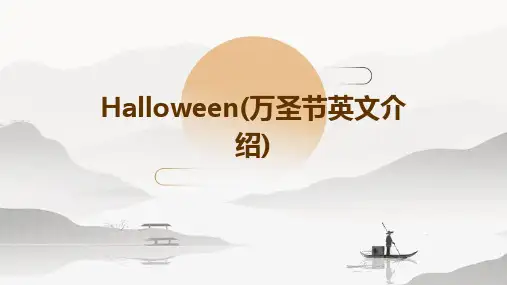

万圣节的介绍资料英文版导读:一、Origin of Halloween (万圣节起源):Halloween is one of the world’s oldest holidays, celebrated in several countries around the world including the USA, Canada, England, Ireland, Scotland, Mexico, Latin America, and Spain.万圣节是世界上最古老的节日之一,在10 月31日这天,有许多国家,如:美国,加拿大,英格兰,爱尔兰,苏格兰,墨西哥,拉丁美洲,西班牙等,都会庆祝万圣节的来临。
The Celtic peoples lived over 2,000 years ago In the place that is now Ireland, the United Kingdom, and Northern France.Halloween’s origins date back to the ancient Celtic festival of Samhain (pronounced sow-in).在2000多年前的爱尔兰及法国北部,住着一群凯尔特人,而万圣节就是起源于古凯尔特人的一个叫做Samhain的节庆。
For the Celtic peoples, the New Year was celebrated on November 1st of every year. This date marked the end of Summer and the beginning of Winter. And this time of year often associated with human death.凯尔特人选在每年November 1st ,11月1日庆祝新年,正值夏天结束,冬天刚开始的时节,多半让人联想到黑暗的死亡。
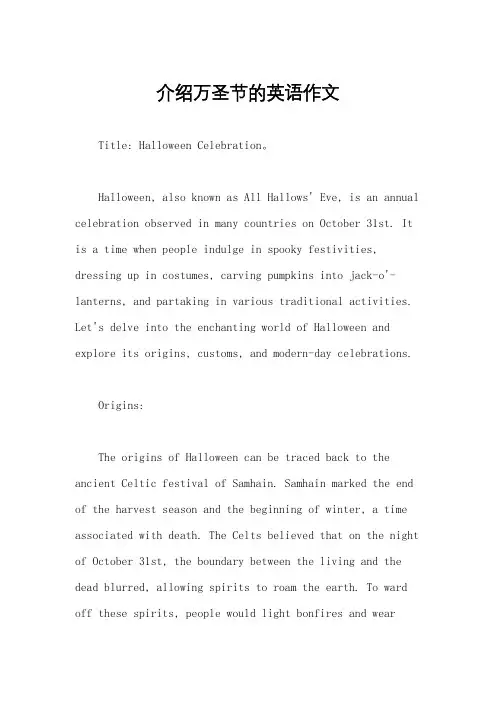
介绍万圣节的英语作文Title: Halloween Celebration。
Halloween, also known as All Hallows' Eve, is an annual celebration observed in many countries on October 31st. It is a time when people indulge in spooky festivities, dressing up in costumes, carving pumpkins into jack-o'-lanterns, and partaking in various traditional activities. Let's delve into the enchanting world of Halloween and explore its origins, customs, and modern-day celebrations.Origins:The origins of Halloween can be traced back to the ancient Celtic festival of Samhain. Samhain marked the end of the harvest season and the beginning of winter, a time associated with death. The Celts believed that on the night of October 31st, the boundary between the living and the dead blurred, allowing spirits to roam the earth. To ward off these spirits, people would light bonfires and wearcostumes to disguise themselves.Customs and Traditions:One of the most iconic customs of Halloween is dressing up in costumes. People of all ages, from young children to adults, embrace the opportunity to become someone—or something—else for a night. Popular costume choices range from classic witches and ghosts to superheroes and movie characters.Another hallmark of Halloween is the carving of pumpkins into jack-o'-lanterns. Originally, turnips were hollowed out and carved with frightening faces to ward off evil spirits. However, when Irish immigrants brought the tradition to America, they discovered that pumpkins were more readily available and easier to carve. Thus, the tradition of carving pumpkins became synonymous with Halloween.Trick-or-treating is another beloved Halloween tradition, especially among children. Dressed in theircostumes, children go from door to door in their neighborhoods, saying "trick or treat" in exchange for candy or other treats. This tradition is said to have originated from the medieval practice of "souling," where poor individuals would go door to door offering prayers for the dead in exchange for food.Haunted houses, corn mazes, and Halloween-themedparties are also popular activities during the Halloween season. These events provide opportunities for people to experience thrills and chills in a controlled environment, adding to the overall festive atmosphere.Modern-Day Celebrations:In modern times, Halloween has evolved into a highly commercialized holiday, with retailers offering a plethora of costumes, decorations, and themed merchandise. Additionally, Halloween-themed events and attractions, such as haunted hayrides and spooky-themed amusement parks, draw crowds seeking seasonal entertainment.Furthermore, Halloween has become a global phenomenon, with celebrations spreading to countries around the world. While some cultures may have their own unique customs and traditions, the essence of Halloween—dressing up, indulging in treats, and embracing the spirit of the supernatural—remains universal.Conclusion:In conclusion, Halloween is a time-honored tradition that continues to captivate people of all ages with its blend of spooky fun and festive revelry. Whether it's carving pumpkins, donning costumes, or trick-or-treating with friends and family, Halloween offers a chance to embrace the magic of the season and indulge in a bit of playful mischief. So, as the autumn leaves fall and the air grows crisp, let us join together in celebrating the enchanting spectacle that is Halloween.。
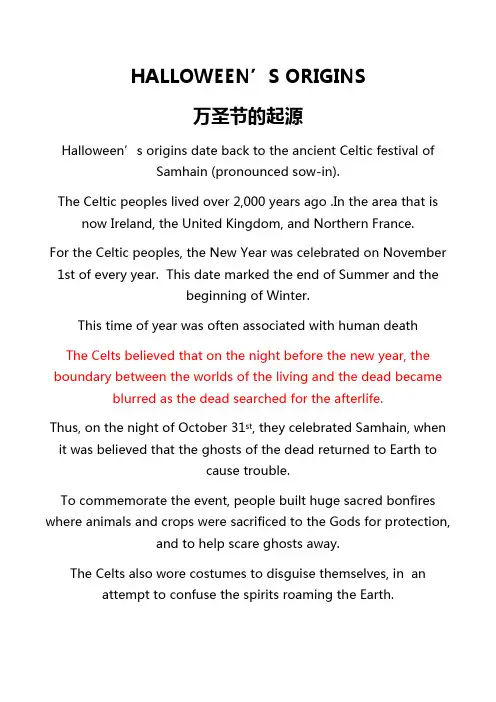
HALLOWEEN’S ORIGINS万圣节的起源Halloween’s origins date back to the ancient Celtic festival ofSamhain (pronounced sow-in).The Celtic peoples lived over 2,000 years ago .In the area that is now Ireland, the United Kingdom, and Northern France.For the Celtic peoples, the New Year was celebrated on November 1st of every year. This date marked the end of Summer and thebeginning of Winter.This time of year was often associated with human deathThe Celts believed that on the night before the new year, the boundary between the worlds of the living and the dead became blurred as the dead searched for the afterlife.Thus, on the night of October 31st, they celebrated Samhain, when it was believed that the ghosts of the dead returned to Earth tocause trouble.To commemorate the event, people built huge sacred bonfires where animals and crops were sacrificed to the Gods for protection,and to help scare ghosts away.The Celts also wore costumes to disguise themselves, in an attempt to confuse the spirits roaming the Earth.By the A.D. 800’s, the influence of Christianity had spread intoCeltic lands.Pope Boniface IV designated November 1stAll Saints Day, a time to honor Saints and Martyrs. It was known asAll Hallowmas.Thus, October 31st became known as All Hallows Eve, and eventually was shortened to the current day title,Halloween.在2000多年前的爱尔兰地区及法国北部,住着一群凯尔特人,而万圣节就是起源于古塞尔特人的一个叫做Samhain的节庆。
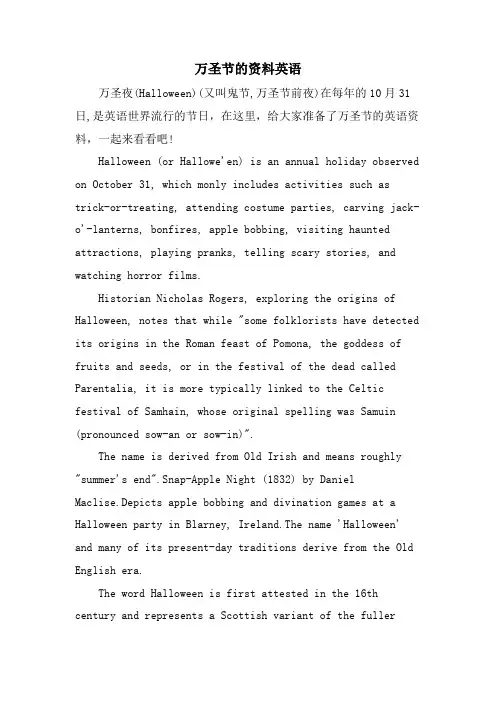
万圣节的资料英语万圣夜(Halloween)(又叫鬼节,万圣节前夜)在每年的10月31日,是英语世界流行的节日,在这里,给大家准备了万圣节的英语资料,一起来看看吧!Halloween (or Hallowe'en) is an annual holiday observed on October 31, which monly includes activities such astrick-or-treating, attending costume parties, carving jack-o'-lanterns, bonfires, apple bobbing, visiting haunted attractions, playing pranks, telling scary stories, and watching horror films.Historian Nicholas Rogers, exploring the origins of Halloween, notes that while "some folklorists have detected its origins in the Roman feast of Pomona, the goddess of fruits and seeds, or in the festival of the dead called Parentalia, it is more typically linked to the Celtic festival of Samhain, whose original spelling was Samuin (pronounced sow-an or sow-in)".The name is derived from Old Irish and means roughly "summer's end".Snap-Apple Night (1832) by DanielMaclise.Depicts apple bobbing and divination games at a Halloween party in Blarney, Ireland.The name 'Halloween' and many of its present-day traditions derive from the Old English era.The word Halloween is first attested in the 16th century and represents a Scottish variant of the fullerAll-Hallows-Even ("evening"), that is, the night before All Hallows Day.[4] Although the phrase All Hallows is found in Old English (ealra hālgena m?ssed?g, mass-day of all saints), All-Hallows-Even is itself not attested until 1556.As European immigrants came to America, they brought their varied Halloween customs with them. Because of the rigid Protestant belief systems that characterized early New England, celebration of Halloween in colonial times was extremely limited there.It was much more mon in Maryland and the southern colonies. As the beliefs and customs of different European ethnic groups, as well as the American Indians, meshed, a distinctly American version of Halloween began to emerge.The first celebrations included "play parties," public events held to celebrate the harvest, where neighbors would share stories of the dead, tell each other's fortunes, dance, and sing. Colonial Halloween festivities also featured the telling of ghost stories and mischief-makingof all kinds. By the middle of the nieenth century, annual autumn festivities were mon, but Halloween was not yet celebrated everywhere in the country.In the second half of the nieenth century, America was flooded with new immigrants. These new immigrants,especially the millions of Irish fleeing Ireland's potato famine of 1846, helped to popularize the celebration ofHalloween nationally. Taking from Irish and English traditions, Americans began to dress up in costumes and go house to house asking for food or money, a practice that eventually became today's "trick-or-treat" tradition. Young women believed that, on Halloween, they could divine the name or appearance of their future husband by doing tricks with yarn, apple parings, or mirrors.In the late 1800s, there was a move in America to mold Halloween into a holiday more about munity and neighborly get-togethers, than about ghosts, pranks, and witchcraft.At the turn of the century, Halloween parties for both children and adults became the most mon way to celebrate the day. Parties focused on games, foods of the season, and festive costumes.Parents were encouraged by newspapers and munity leaders to take anything "frightening" or "grotesque" out of Halloween celebrations. Because of their efforts, Halloween lost most of its superstitious and religious overtones by the beginning of the twentieth century.By the 1920s and 1930s, Halloween had bee a secular, but munity-centered holiday, with parades and town-wide parties as the featured entertainment. Despite the best efforts of many schools and munities, vandalism began to plague Halloween celebrations in many munities during this time.By the 1950s, town leaders had suessfully limited vandalism and Halloween had evolved into a holiday directed mainly at the young. Due to the high numbers of young children during the fifties baby boom, parties moved from town civic centers into the classroom or home, where they could be more easily aommodated.Between 1920 and 1950, the centuries-old practice of trick-or-treating was also revived. Trick-or-treating was a relatively inexpensive way for an entire munity to share the Halloween celebration.In theory, families could also prevent tricks being played on them by providing the neighborhood children with small treats. A new American tradition was born, and it has continued to grow. Today, Americans spend an estimated $6.9 billion annually on Halloween, making it the country's second largest mercial holiday.。
万圣节英文介绍及翻译Halloween, also known as All Hallows' Eve, is a yearly celebration observed in many countries on October 31st, the eve of the Western Christian feast of All Hallows' Day. It is a time when people dress up in costumes, attend parties, go trick-or-treating, visit haunted attractions, carve pumpkins into jack-o'-lanterns, and watch horror films. The origins of Halloween can be traced back to the ancient Celtic festival of Samhain, where people would light bonfires and wear costumes to ward off ghosts. Over time, Halloween evolved into a secular holiday that is celebrated with a mix of traditional and modern customs.One of the most iconic symbols of Halloween is theJack-o'-lantern, a carved pumpkin with a candle inside. The tradition of carving pumpkins originated from an Irish folktale about a man named Stingy Jack, who tricked the Devil and was cursed to roam the earth with only a burning coal inside a turnip. When Irish immigrants brought the tradition to America, they discovered that pumpkins weremore readily available and easier to carve, leading to the creation of the Jack-o'-lantern as we know it today. In addition to pumpkins, other popular Halloween decorations include skeletons, witches, ghosts, and black cats, all of which are associated with the supernatural and the macabre.Trick-or-treating is a beloved Halloween tradition where children dress up in costumes and go door-to-door asking for candy. The practice can be traced back to the medieval custom of "souling," where poor people would go from house to house asking for food in exchange for prayers for the dead. Over time, the tradition evolved intochildren asking for treats, with the threat of tricks if they were refused. Today, trick-or-treating is a fun and festive activity that brings communities together and allows children to indulge in sweet treats while showingoff their creative costumes.Halloween parties are another popular way to celebrate the holiday, with people of all ages coming together to enjoy food, drinks, games, and music. Costumes are a key component of Halloween parties, with guests often competingfor the best and most creative outfit. Some popular costume themes include classic monsters like vampires and werewolves, pop culture icons, superheroes, and historical figures. In addition to costumes, Halloween parties often feature spooky decorations, such as cobwebs, bats, and fake blood, to create a festive and eerie atmosphere.Haunted attractions are a thrilling way to experience the spooky spirit of Halloween, with haunted houses, hayrides, corn mazes, and theme parks offering scares and thrills for those brave enough to enter. These attractions often feature actors in costume, special effects, and jump scares to create a sense of terror and suspense. For many people, visiting a haunted attraction is a fun and adrenaline-pumping way to get into the Halloween spirit and enjoy a good scare with friends and family. Some haunted attractions even offer "extreme" experiences for those looking for an extra dose of fear and excitement.In conclusion, Halloween is a festive and fun holiday that combines ancient traditions with modern customs to create a unique and exciting celebration. From dressing upin costumes and carving pumpkins to trick-or-treating and attending parties, there are countless ways to enjoy the spooky spirit of Halloween. Whether you prefer a night of scares at a haunted attraction or a cozy evening at home watching horror movies, Halloween offers something for everyone to enjoy. So gather your friends and family, put on your best costume, and get ready to celebrate the magic and mystery of All Hallows' Eve.。
万圣节的资料英语版October 31st (western countries)Halloween is one of the oldest holidays with origins going back thousands of years.The holiday has had many influences from many cultures over the centuries. From the Roman's Pomona Day, to the Celtic festival of Samhain,to the Christian holidays of All Saints and All Souls Days. Hundreds of years ago in what is now Great Britain and Northern France, lived the Celts (凯尔特人), who worshipped nature and had many gods, with the sun god as their favorite. They celebrated their New Year on November 1st which was made every year with a festival and marked the end of the "season of the sun" and the beginning of "the season of darkness and cold. "On October 31st after the crops were all harvested and stored for the long winter the cooking fires in the homes would be extinguished. The Druids, the Celtic priests, would meet in the hilltop in the dark oak forest (oak trees were considered sacred). They would light new fires and offer sacrifices of crops and animals. As they danced around the fires, the season of the sunpassed and the season of darkness would begin. When the morning arrived the Druids would give an ember from their fires to each family who would then take them home to start new cooking fires. These fires would keep the homes warm and free from evil November 1st festival was called Samhain pronounced "sow-en"). The festival would last for 3 days. Many people would parade in costumes made from the skins and heads of their animals. This festival would become the first Halloween.The Celtics would carry a lantern when they walked on the eve of October 31. These lanterns were carved out of big turnips (大头菜) and the lights were believed to keep the evil spirits away. Children would carve faces in the turnips. These carved turnips were called "jack-o-lanterns. It is said that the jack-o-lantern" got its name from a stingy and mean old man, named Jack, who when he died was too mean to get into heaven. When Jack went to hell he was meet by the Devil who gave him a piece of burning coal and sent him away. Jack placed the burning coal in a turnip to use as a lantern to light his way. The legends claim that Jack is still walking with the lantern looking for a place to the earlysettlers came to America they found the big round orange pumpkin. Being larger and much more colorful than turnips, the pumpkin made great "jack-o-lanterns". Eventually the pumpkin would replace the turnip. Eventually the Pumpkin would become the most widely recognized symbol of the Halloween holiday. The history of "Trick'O'Treating" can be traced back to the early celebrations of All Soul's Day in Britain. The poor would go begging and the housewives would give them special treats called "soulcakes". This was called "going a-souling", and the "soulers" would promise to say a prayer for the time the custom changed and the town's children became the beggars. As they went from house to house they would be given apples, buns (圆形的小甜面包), and money. During the Pioneer days of the American West, the housewives would give the children candy to keep from being tricked. The children would shout "Trick or Treat!".。
万圣节的英文资料Halloween originated as a celebration connected with evil spirits. Witches flying on broomsticks with ghosts, goblins and skeletons have all evolved as symbols of Halloween. Bats, owls and other nocturnal animals are also popular symbols of Halloween. They were originally feared because people believed that these creatures could communicate with the spirits of the dead.Black cats are also symbols of Halloween and have religious origins as well. Black cats were considered to be reincarnated beings with the ability to divine the future. During the Middle Ages it was believed that witches could turn themselves into black cats. Thus when such a cat was seen, it was considered to be a witch in disguise. All these are popular trick-or-treat costumes and decorations for greeting cards and windows.Black is one of the traditional Halloween colors, probably because Halloween festivals and traditions took place at night.Pumpkins are also a symbol of Halloween. Thepumpkin is an orange-colored squash, and orange has become the other traditional Halloween color. Carving pumpkins into jack- o'-lanterns is a Halloween custom also dating back to Ireland. A legend grew up about a man named Jack who was so stingy that he was not allowed into heaven when he died, because he was a miser. He couldn't enter hell either because he had played jokes on the devil. As a result, Jack had to walk on the earth with his lantern until Judgement Day. So Jack and his lantern became the symbol of a lost or damned soul. To scare these souls away on Halloween, the Irish people carved scary faces out of turnips, beets or potatoes representing "Jack of the Lantern," or Jack-o-lantern. When the Irish brought their customs to the United States, they carved faces on pumpkins because in the autumn they were more plentiful than turnips. Today jack-o-lanterns in the windows of a house on Halloween night let costumed children know that there are goodies waiting if they knock and say "Trick or Treat!"万圣节前夜起源于与邪恶幽灵相关的庆贺活动,因此骑着扫帚的女巫、幽灵、小妖精和骷髅都是万圣节的标志物。
万圣节的资料英文版【万圣节的发展】As European immigrants came to America, they brought their varied Halloween customs with them. Because of the rigid Protestant belief systems that characterized early New England, celebration of Halloween in colonial times was extremely limited there.It was much more common in Maryland and the southern colonies. As the beliefs and customs of different European ethnic groups, as well as the American Indians, meshed, a distinctly American version of Halloween began to emerge.The first celebrations included "play parties," public events held to celebrate the harvest, where neighbors would share stories of the dead, tell each other's fortunes, dance, and sing.Colonial Halloween festivities also featured the telling of ghost stories and mischief-making of all kinds. By the middle of the nineteenth century, annual autumn festivities were common, but Halloween was not yet celebrated everywhere in the country.In the second half of the nineteenth century, America was flooded with new immigrants.These new immigrants, especially the millions of Irish fleeing Ireland's potato famine of 1846, helped to popularize the celebration of Halloween nationally. Taking from Irish and English traditions, Americans began to dress up in costumes and go house to house asking for food or money, a practice that eventually became today's "trick-or-treat" tradition.Young women believed that, on Halloween, they could divine the name or appearance of their future husband by doing tricks with yarn, apple parings, or mirrors.In the late 1800s, there was a move in America to mold Halloween into a holiday more about community and neighborly get-togethers, than about ghosts, pranks, and witchcraft.At the turn of the century, Halloween parties for both children and adults became the most common way to celebrate the day. Parties focused on games, foods of the season, and festive costumes. Parents were encouraged by newspapers and community leaders to take anything "frightening" or "grotesque" out of Halloween celebrations. Because of their efforts, Halloween lost most of its superstitious and religious overtones by the beginning of the twentieth century.By the 1920s and 1930s, Halloween had become a secular, but community-centered holiday, with parades and town-wide parties as the featured entertainment. Despite the best efforts of many schools and communities, vandalism began to plague Halloween celebrations in many communities during this time.By the 1950s, town leaders had successfully limited vandalism and Halloween had evolved into a holiday directed mainly at the young. Due to the high numbers of young children during the fifties baby boom, parties moved from town civic centers into the classroom or home, where they could be more easily accommodated.Between 1920 and 1950, the centuries-old practice of trick-or-treating was also revived. Trick-or-treating was a relatively inexpensive way for an entire community to share the Halloween celebration. In theory, families could also prevent tricks being played on them by providing the neighborhood children with small treats.A new American tradition was born, and it has continued to grow. Today, Americans spend an estimated $6.9 billion annually on Halloween, making it the country's second largest commercial holiday.。
介绍万圣节的英语作文Title: Halloween: A Festive Dive into Spooky Traditions。
Halloween, also known as All Hallows' Eve, is a celebration observed in several countries on October 31st.It's a time when people indulge in spooky festivities, don costumes, and embrace the thrill of the supernatural. This ancient tradition has evolved over centuries, blending pagan rituals with Christian influences to become thevibrant and captivating holiday we know today.The origins of Halloween can be traced back to the ancient Celtic festival of Samhain. Samhain marked the endof the harvest season and the beginning of winter, a time associated with death in Celtic culture. It was believedthat on the night of October 31st, the boundary between the living and the dead blurred, allowing spirits to roam the earth. To ward off these malevolent entities, people lit bonfires and wore costumes to disguise themselves.As Christianity spread across Europe, Samhain merged with the Christian holiday of All Saints' Day, which honored saints and martyrs. The evening before All Saints' Day became known as All Hallows' Eve, eventually morphing into Halloween. Despite its Christian overlay, many of the pagan customs persisted, including wearing costumes and lighting bonfires.Today, Halloween is celebrated with a variety of traditions that have evolved over time. One of the most iconic aspects of Halloween is trick-or-treating, where children dress up in costumes and go from house to house collecting candy. This tradition likely stems from the medieval practice of "souling," where poor people would go door to door on All Souls' Day asking for food in exchange for prayers for the dead.Another popular Halloween tradition is carving pumpkins into jack-o'-lanterns. This custom originated in Ireland, where turnips were hollowed out and carved with scary faces to ward off evil spirits. When Irish immigrants brought the tradition to America, they found pumpkins to be moreabundant and easier to carve, leading to the modern-day tradition of pumpkin carving.Haunted houses, costume parties, and horror movie marathons are also common Halloween activities. These modern traditions embrace the spooky and macabre elements of the holiday, allowing people to revel in the thrill of fear in a safe and controlled environment.In addition to its festive aspects, Halloween also has cultural significance. It serves as a time for communities to come together and celebrate shared traditions. It's a time for creativity and self-expression through costume design and pumpkin carving. Moreover, it provides an opportunity for people to confront their fears in a lighthearted manner, fostering resilience and courage.Overall, Halloween is a rich tapestry of ancient customs, religious influences, and modern traditions. It's a time to embrace the spooky and supernatural, to indulge in sweet treats, and to celebrate the vibrant tapestry of human culture. Whether you're donning a costume, carving apumpkin, or simply enjoying the atmosphere, Halloween offers something for everyone to enjoy.。
万圣节英文资料万圣节英文资料万圣节起初是一个异教徒的节日,纪念死去的人。
万圣节源于圣徒日前夜,始于2000多年前。
关于万圣节大家还知道什么呢?一起来看看店铺给大家准的万圣节的资料吧!【The Origin of Halloween万圣节的起源】While there are many versions of the origins and old customs of Halloween, some remain consistent by all accounts. Different cultures view Halloween somewhat differently but traditional Halloween practices remain the same。
尽管关于万圣节的起源和旧俗有很多不同的看法,但有一些是被所有人接受的。
不同文化看待万圣节总是有点不同,但是传统的万圣节做的事情都是一样的。
Halloween culture can be traced back to the Druids, a Celtic culture in Ireland, Britain and Northern Europe. Roots lay in the feast of Samhain, which was annually on October 31st to honor the dead。
万圣节文化可以追溯到德鲁伊教,这是一种爱尔兰、北欧和英国的凯尔特文化,根植于Samhain节的庆祝活动,Samhain节于每年的10月31日纪念逝者。
Samhain signifies "summers end" or November. Samhain was a harvest festival with huge sacred bonfires, marking the end of the Celtic year and beginning of a new one. Many of the practices involved in this celebration were fed on superstition。
万圣节的资料英语
Halloween is an autumn holiday that Americans celebrate every year. It means "holy evening," and it comes every October 31, the evening before All Saints' Day. However, it is not really a church holiday, it is a holiday for children mainly.
Every autumn, when the vegetables are ready to eat, children pick large orange pumpkins. Then they cut faces in the pumpkins and put a burning candle inside. It looks as if there were a person looking out of the pumpkin! These lights are called jack-o'-lanterns, which means "Jack of the lantern".
The children also put on strange masks and frightening costumes every Halloween. Some children paint their faces to look like monsters. Then they carry boxes or bags from house to house. Every time they come to a new house, they say,"Trick or treat! Money or eat!" The grown-ups put treat-money or candy in their bags.
Not only children, but most grown-ups also love Halloween and Halloween parties because on this day,they can disguise themselves as personages or ghost as their imaginations will lead them. This bring them
the satisfaction of being young.
Dressing in masks and costumes is a popular Halloween activity. Costumes can be traditional and scary, such as a witch’s pointy hat and black gown. Costumes may also have a modern flavor. Many children dress up as movie characters or a favorite superhero.
But Halloween is not just for children. Many adults enjoy showing off their costumes at Halloween parties!
Once in costume, children go from house to house saying “Trick or treat!” In the past, children might play a “trick” on people who did not give treats. They might pelt houses with eggs or old tomatoes, or play other pranks. Today, children’s cries of “Trick or treat!” are usually rewarded with candy.
One of the oldest Halloween traditions comes from the ancient Celts, who lived in western and central Europe long ago. The Celts celebrated a holiday y called Saamhain on October 31. After sunset that day, people believed that spirits of the dead would rise and walk the earth. The Celts made offerings of food and drink to keep the spirits away.
Beginning about 2,000 years ago, the Roman Empire
conquered many Celtic peoples. But Celtic traditions, including Samhain, remained strong in areas such as Ireland and Scotland, even after the Roman conquest.
The Roman Catholic Church tried to replace Samhain in 835 with All Saints’ Day, a day to honor saints of the Church. The eve of All Saints’ Day is October 31. It is called Allhallows or Hallowmas by the Church.
Halloween first came to America with early settlers from Celtic areas in Europe, such as Ireland and Scotland. But other American settlers with strict religious beliefs, including the Puritans from England, rejected Halloween. The arrival of many Irish immigrants during the 1800s helped spread Halloween’s popularity.
But by the late 1800s, fewer people believed in ancient superstitions of ghosts and witches. Halloween became more a holiday for children to receive treats and dress in costume.。